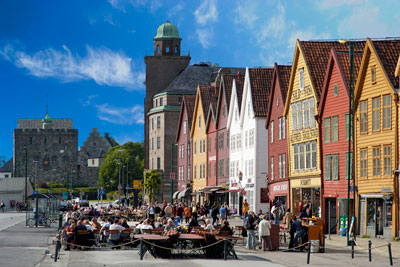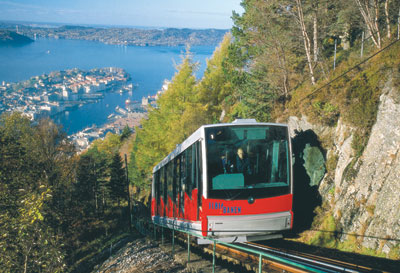The Bergen Line
This item appears on page 60 of the March 2010 issue.
You are well above the timberline far north, running along the stark, clear-aired, snow-pocked edge of Norway’s Hardanger Plateau. Any speck of color seems to be out of place. Just before your train stops at Myrdal, you look to your right and see the browns and greens of the mountain walls of a grand canyon of a rift. You gasp at the sight many hundreds of feet down the temperate Flåm Valley.
At Myrdal Station, dominated by a mountain with icy whiskers of frozen waterfalls, you don your parka and bundle into the coaches of the waiting apple-green Flåm train. You leave behind a high, bleak and contrary glacial plateau for the green, serene beauty of one of Norway’s sweetest valleys.
Your trip doesn’t take long, but minute by minute, as your train inches down Europe’s steepest adhesion line and turns surprising corners, you are rewarded by one of the most breathtaking of Norway’s adventurous trains.
Your descent along the Flåm Line is your first leg of “Norway in a Nutshell,” the three-stage excursion that reveals the essence of this beautiful country. For the second leg, board Kaptain Lid Kjell’ s Skagastol at Flåm’s pier, located at the end of the rail line, to begin a tranquil cruise on both the Auriandsfjord and the Nærøyfjord, which are branches of the larger Sognefjord.
As the color of the fjord lightens and the Nærøyfjord becomes shallower, Kaptain Kjell orders the motor stopped and you cruise the final stretch up to the landing at Gudvangen. It is your assembly point for the low-gear, one-hour bus climb through the hairpin curves of the Stalheimskleivana road to Voss through the narrow Nærøy Valley. It is one of Northern Europe’s steepest stretches
From the start
Your Bergen Line train’s early-morning departure had hurried punctually out of Oslo Sentral Station through built-up Oslo and past the suburbs. Climbing alongside a broad river, you had first passed flowery meadows, placid lakes and foliage brightened by red rowanberries.
Thirty minutes past Drammen, dramatic scenery unfolds. You see the waters running faster. The trees thin. Patches of snow appear. The country is mantled in white by the time you arrive in Geilo. At 2,650 feet you are only miles short of the timberline.
Geilo, known as the St. Moritz of Norway for its excellent skiing, is also a good base for mountaineering in summer. You can hire bicycles to follow Northern Europe’s most popular biking route, the Rallarvegen (Railer Road), the Bergen Line’s construction road, which is now closed to automobiles for most of its length, and return your bicycle in Flåm or even Voss.
As you continue to climb, the scenery changes from ski resort to glacier. You leave the last of the trees at Ustaoset.
At Storodi, about six miles east of Finse, which is the highest stop on the line, your train accelerates to nearly 105 mph. A nine-mile segment of new line, built on a low embankment to ease snow-clearance problems, was put into service in 1999. The landscape glares whitely. It is dominated by the frigid Hardanger Glacier looming in the south higher by 2,000 feet than Finse (4,010 feet). George Lucas filmed here the bitterly cold opening sequences of “The Empire Strikes Back.”
West of Finse you enter the 1993, 6.4-mile Finse Tunnel, which prevents line closings due to avalanches. The tunnel cut 2.7 miles from the length of your trip. Curiously, the highest point of the line, 4,123 feet, is in this tunnel. Before the tunnel was built, the highest point was at 4,267 feet.
Heading home
Suddenly you realize the snow is melting and the water is running west instead of east, and you know your train is descending to Bergen and the North Sea’s warm Gulf Stream.
Leaving the bleak and wind-scoured land of snow, you pass giant waterfalls and valleys with dazzling, purple rhododendrons blooming all around you.
No sooner do you clear your ears from the increasing air pressure than you are rolling along the shores of Sorfjorden and then through the five-mile Ulriken Tunnel into Bergen’s end-of-the-line train terminal, where the glass arches were restored in 1992 to the classical style of the 1930s, when steam locomotives were used.
Named a “Cultural Capital of Europe” for 2000, Bergen is a vital city, a major gateway opening on the West, the former home of Edvard Grieg and the center of an international music festival. It has, reputedly, the finest youth hostel in the north.
Hansa merchants came to Bergen in the Middle Ages. From the 14th to the mid-16th century, Bergen gained importance as the Hansa’s trade center for dried fish. Bryggen, the preserved Hanseatic wharf, was inscribed as a UNESCO World Heritage Site in 1979. The Finnegården Museum inside is a replica of a typical Hansa shop with all its curious secrets.
For a scenic overview and orientation of Bergen and its harbor setting, the six-minute ride on Scandinavia’s only funicular takes you to the top of 1,050-foot-high Mount Fløien.
For another perspective, reopened on May 1, 2009, an upgraded aerial cableway takes you to the summit of Mount Ulriken, the highest of Bergen’s six mountains. On a ledge near the summit, sitting on the restaurant’s outdoor, sheepskin-covered benches reveals Bergen and the sea as well as the fjords and mountains that surround the city. The indoor restaurant serves traditional Bergen fare.
In Bergen (www.visitbergen.com), I stayed at the historic Clarion Connection Hotel Havnekontoret (phone +47 55 60 1100), with rates from NOK1,695 (near $300). In Oslo, the modern Thon Hotel Opera (phone +47 24 10 30 00), with rates from N0K675 ($120), has a covered walkway to the terminal of the Airport Express train.
I thank Innovation Norway-Tourism (phone 21 2885‑975 1) for providing my trip, including hotel and train arrangements as well as SAS flights to and from Germany.


